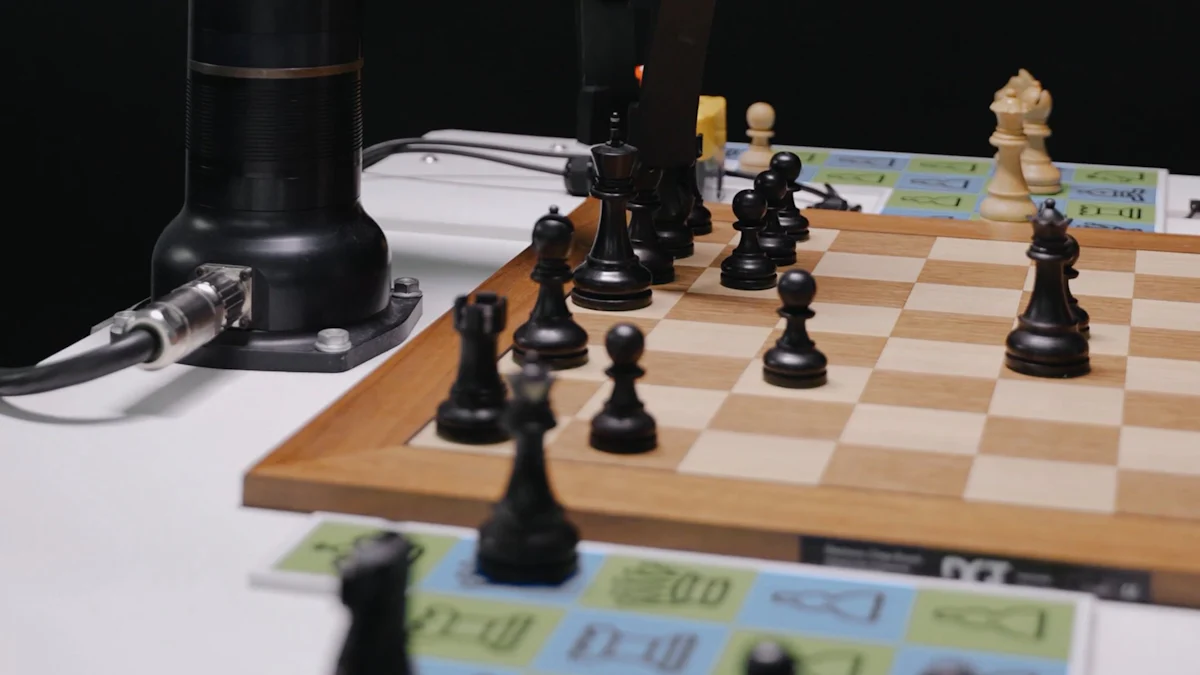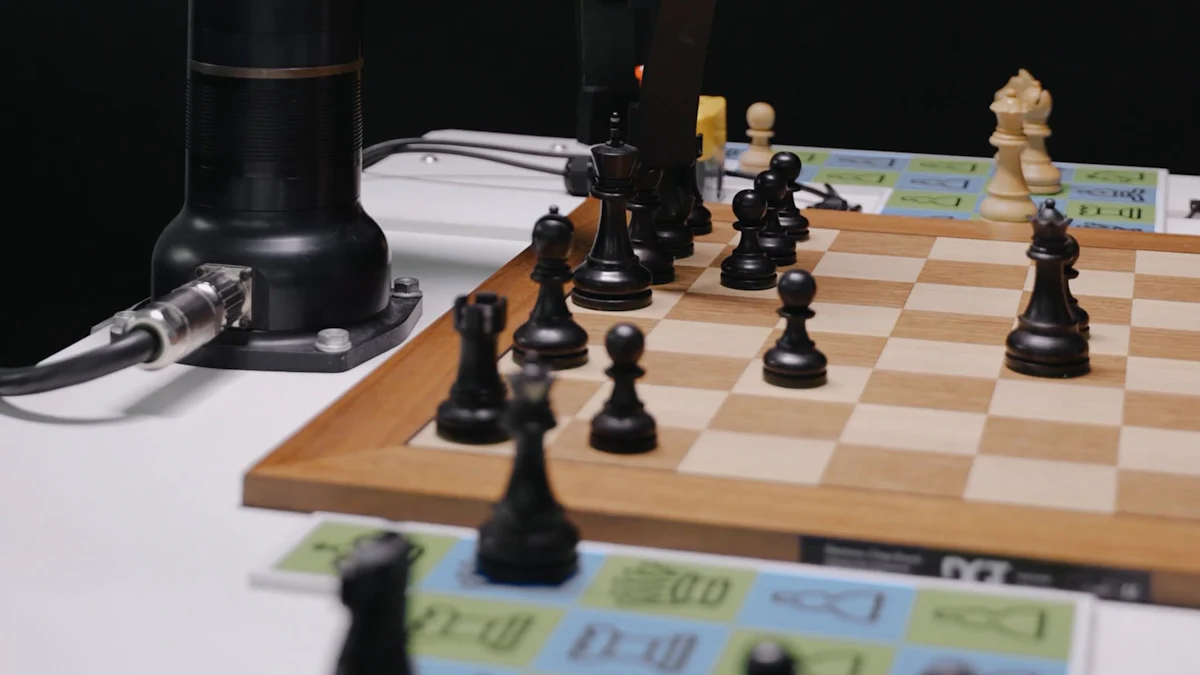Harnessing Generative AI for Dynamic Game Content Creation

Generative AI is revolutionizing the gaming industry by creating unique and dynamic content. You might wonder why this matters. Well, in today's gaming world, players crave fresh experiences. They want games that adapt and surprise them. Generative AI uses advanced machine learning algorithms to analyze patterns in digital data, producing content that feels new and exciting. This technology not only enhances creativity but also boosts efficiency in game development. As a result, the market for Generative AI in gaming is expected to grow by 23.3% between 2023 and 2032, reaching a staggering $7.105 million.
Understanding Generative AI
Definition and Core Concepts
What is Generative AI?
Generative AI is a fascinating technology that creates new content by learning from existing data. Imagine a machine that can paint a picture or compose music by understanding patterns and styles. That's what Generative AI does. It uses algorithms to generate content that feels fresh and original. In gaming, this means creating levels, characters, and even entire worlds that are unique every time you play.
Key Technologies Involved
To make this magic happen, Generative AI relies on several key technologies. Machine learning is at the heart of it all. It allows computers to learn from data and improve over time. Neural networks, which mimic the human brain, help in understanding complex patterns. Then there's deep learning, a subset of machine learning, which excels at recognizing intricate details. These technologies work together to create the dynamic content you see in modern games.
Historical Context
Evolution of AI in Gaming
AI in gaming has come a long way since its early days. Back in the 1950s and 1960s, the first instances of AI appeared in simple games like tic-tac-toe and chess. These early experiments showcased AI's potential, even in a rudimentary form. Fast forward to today, and AI has become an integral part of gaming, offering more responsive and immersive experiences.
Milestones in Generative AI Development
The journey of Generative AI in gaming is marked by significant milestones. One notable event was the introduction of Dynamic Difficulty Adjustment (DDA), which allowed games to adapt to a player's skill level, providing a more personalized experience. Over the years, advancements in AI have continued to shape the gaming landscape, leading to the creation of more complex and engaging content. These developments have paved the way for the exciting possibilities we see today with Generative AI.
The Role of Generative AI in Game Development

Generative AI is reshaping the landscape of game development. It acts as a catalyst for creativity and innovation, while also automating content generation. Let's dive into how this technology is transforming the gaming world.
Enhancing Creativity and Innovation
AI as a Creative Partner
Imagine having a creative partner that never tires and constantly brings fresh ideas to the table. That's what Generative AI does for game developers. It analyzes vast amounts of data to generate new concepts, designs, and even entire game worlds. You can think of it as a collaborator that helps you push the boundaries of what's possible in gaming. By working alongside AI, developers can explore uncharted territories and create experiences that captivate players.
Examples of AI-Driven Creativity
Generative AI has already made its mark with some impressive examples. For instance, in the game No Man's Sky, AI algorithms generate an entire universe with unique planets, ecosystems, and creatures. Each player's journey is different, offering endless exploration opportunities. Another example is Spelunky, where AI creates randomized levels, ensuring that no two playthroughs are the same. These instances highlight how AI can inject creativity into games, making them more engaging and unpredictable.
Automating Content Generation
Procedural Content Generation
Procedural content generation (PCG) is one of the most exciting applications of Generative AI. It automates the creation of diverse and complex game content, such as levels, maps, and quests. This approach not only saves time but also reduces costs. Developers can focus on refining gameplay mechanics and storytelling, while AI handles the heavy lifting of content creation. The result? Games that feel vast and dynamic, with minimal manual effort.
Case Study: Neoverse Games
Neoverse Games integrated AI into their development process, leading to enhanced player engagement and reduced content generation time and cost. This case study demonstrates the potential of AI in streamlining game development processes and enriching player experiences.
AI-Generated Storylines and Characters
Generative AI doesn't stop at creating environments. It also crafts storylines and characters that adapt to your choices. Imagine a game where the narrative evolves based on your actions, offering a personalized experience every time you play. AI-driven storylines can introduce unexpected twists and turns, keeping you on the edge of your seat. Characters generated by AI can exhibit unique personalities and behaviors, adding depth and realism to the game world.
Benefits of Dynamic Game Content
Dynamic game content offers a treasure trove of benefits that can elevate your gaming experience to new heights. Let's explore how it enhances player engagement and streamlines development processes.
Increased Player Engagement
Personalized Gaming Experiences
Imagine stepping into a game world that feels tailor-made just for you. Dynamic content makes this possible by adapting to your preferences and playstyle. It creates a personalized journey where your choices shape the narrative and gameplay. This level of customization keeps you invested and eager to explore every corner of the game. In fact, games with dynamic content have seen a *40% increase in average playtime per user*. This means you're more likely to stay engaged and return for more adventures.
Adaptive Gameplay Mechanics
Dynamic content doesn't stop at personalization. It also introduces adaptive gameplay mechanics that respond to your actions. Picture a game where the difficulty adjusts based on your skill level, ensuring a challenging yet enjoyable experience. This adaptability keeps you on your toes and prevents the game from becoming predictable or monotonous. By constantly evolving, the game remains fresh and exciting, encouraging you to dive deeper into its world.
Cost and Time Efficiency
Reducing Development Time
Creating a game from scratch can be a time-consuming process. However, dynamic content generation can significantly cut down on development time. By automating the creation of levels, characters, and storylines, developers can focus on refining gameplay and enhancing the overall experience. This efficiency allows for quicker releases and updates, keeping you engaged with new content more frequently.
Lowering Production Costs
Dynamic content not only saves time but also reduces production costs. Traditional game development often requires extensive resources and manpower. With dynamic content, developers can achieve more with less. Automated processes handle the heavy lifting, resulting in cost-effective production. This means developers can allocate resources to other areas, such as improving graphics or adding new features, ultimately delivering a richer gaming experience for you.
Challenges and Limitations
Generative AI in gaming offers exciting possibilities, but it also presents challenges and limitations. Let's explore some of the technical and ethical hurdles you might encounter.
Technical Challenges
AI Integration in Game Engines
Integrating AI into game engines can be tricky. You need to ensure that AI algorithms work seamlessly with existing systems. This requires a deep understanding of both AI and game development. Sometimes, AI can demand significant computational resources, which might slow down your game. You must balance performance and innovation to create a smooth gaming experience.
Balancing AI Creativity with Control
AI can generate creative content, but you need to maintain control. You want AI to surprise players, but not at the expense of the game's vision. Striking this balance is crucial. You must guide AI to align with your design goals while allowing it to innovate. This requires careful planning and testing to ensure AI-generated content enhances the game rather than detracts from it.
Ethical and Social Considerations
AI Bias and Fairness
AI systems can sometimes exhibit bias. This happens when AI learns from biased data. In gaming, this could lead to unfair or stereotypical representations. You need to be vigilant in training AI models to ensure fairness. Regular audits and diverse data sets can help mitigate bias, creating a more inclusive gaming experience for everyone.
Impact on Game Developers
The rise of AI in gaming raises questions about the role of developers. AI can automate many tasks, potentially reducing the need for human input. This shift might impact job opportunities in the industry. However, it also opens new avenues for creativity and innovation. You can focus on higher-level design and storytelling, leaving repetitive tasks to AI. Embracing this change can lead to more fulfilling and creative roles in game development.
Philosophical Insight: The intersection of AI and game development marks a significant leap forward in interactive entertainment. Understanding these challenges helps you navigate the evolving landscape of gaming, ensuring that AI enhances rather than hinders your creative vision.
Case Studies and Examples
Exploring real-world applications of Generative AI in gaming can provide valuable insights into its transformative potential. Let's dive into some notable examples and experimental projects that showcase the power of this technology.
Successful Implementations
Notable Games Using Generative AI
Several games have successfully integrated Generative AI to create immersive and dynamic experiences. No Man's Sky stands out as a prime example. This game uses AI algorithms to generate an entire universe, complete with unique planets, ecosystems, and creatures. Each player's journey becomes a distinct adventure, offering endless exploration opportunities. Another noteworthy title is Minecraft, where AI-driven procedural generation creates vast landscapes and structures, allowing players to build and explore without limits.
Insight from Industry Leaders: Leading game development studios have harnessed AI to enhance gameplay realism and narrative depth. By integrating AI, these studios have optimized development processes and increased player engagement. This approach illustrates the diverse applications of AI in the gaming industry.
Lessons Learned from Industry Leaders
Industry leaders have shared valuable lessons from their experiences with Generative AI. One key takeaway is the importance of balancing AI creativity with human oversight. While AI can generate vast amounts of content, developers must guide it to align with the game's vision. Another lesson is the need for robust testing and iteration. AI-generated content should undergo thorough evaluation to ensure it enhances the player experience. By learning from these pioneers, you can better navigate the challenges and opportunities of AI in game development.
Experimental Projects
Innovative Uses of AI in Indie Games
Indie game developers have embraced Generative AI to push creative boundaries. Spelunky is a standout example, where AI generates randomized levels, ensuring no two playthroughs are the same. This unpredictability keeps players engaged and eager to explore. Another innovative project is AI Dungeon, an interactive text-based game that uses AI to craft dynamic storylines based on player input. These indie games demonstrate how AI can inject creativity and innovation into gaming, even with limited resources.
Future Prospects and Trends
The future of Generative AI in gaming holds exciting possibilities. Emerging technologies like AI-driven virtual reality and cloud gaming promise to revolutionize player experiences. Imagine stepping into a virtual world where AI adapts the environment and storyline in real-time, creating a truly immersive adventure. As AI continues to evolve, we can expect new game genres and experiences that were once unimaginable. By staying informed about these trends, you can anticipate the next wave of innovation in the gaming industry.
Future of Generative AI in Gaming

The future of gaming looks bright with the integration of Generative AI. This technology is set to revolutionize how you experience games, making them more immersive and personalized. Let's explore some emerging technologies and predictions that could shape the gaming landscape.
Emerging Technologies
AI and Virtual Reality
Imagine stepping into a virtual world where everything adapts to your actions. AI and Virtual Reality (VR) together can make this a reality. AI can create dynamic environments that change based on your interactions. This means every time you play, the experience feels fresh and unique. You might find yourself in a forest that grows denser as you explore or a city that evolves with your decisions. The combination of AI and VR promises to deliver gaming experiences that are more engaging and lifelike than ever before.
AI in Cloud Gaming
Cloud gaming is another area where AI is making waves. With cloud gaming, you can play high-quality games on any device without needing powerful hardware. AI enhances this by optimizing game performance and reducing latency. It ensures that you enjoy smooth gameplay, even on less capable devices. Additionally, AI can personalize your gaming experience by analyzing your preferences and suggesting games that match your interests. This makes cloud gaming not only accessible but also tailored to your tastes.
Predictions and Speculations
Long-term Impact on Game Design
Generative AI will have a profound impact on game design. It allows developers to create vast and intricate worlds with minimal effort. You can expect games to become more complex and detailed, offering richer narratives and deeper gameplay. AI can also help in designing adaptive storylines that respond to your choices, making each playthrough unique. This shift in game design will lead to more immersive and personalized experiences, keeping you engaged for longer periods.
Potential for New Game Genres
The possibilities with Generative AI are endless, and new game genres are likely to emerge. Imagine games where the storyline evolves based on your emotions or where the environment changes in real-time to match your mood. AI can analyze your reactions and adapt the game accordingly, creating a truly interactive experience. This opens up opportunities for innovative game genres that were previously unimaginable. As AI continues to evolve, you can look forward to exploring new and exciting gaming experiences.
Insight from Industry Experts: The evolution of AI in gaming has been remarkable, transforming simple algorithms into complex systems that enhance gameplay and development. This transformation provides valuable insights into how AI will continue to shape the future of gaming.
Practical Considerations for Developers
When diving into the world of Generative AI for game development, you need to equip yourself with the right tools and best practices. This section will guide you through some essential resources and strategies to enhance your game development process.
Tools and Resources
Popular AI Frameworks and Libraries
To harness the power of Generative AI, you should explore some popular frameworks and libraries that can streamline your development process:
Unity ML-Agents: This toolkit integrates machine learning into Unity games. It helps create intelligent NPCs and dynamic environments, making your game world more engaging.
OpenAI's GPT-3: Known for text generation, GPT-3 can enhance storytelling by creating dialogue and narrative elements in games. It adds depth to procedural generation.
Godot Engine: An open-source game engine that supports procedural content generation (PCG) through scripting capabilities. You can create custom algorithms for content generation.
TensorFlow: A versatile machine learning framework suitable for deep learning and reinforcement learning tasks. It offers flexibility and performance, allowing efficient execution of complex operations.
These tools provide a solid foundation for integrating AI into your game development workflow.
Community and Support Networks
Engaging with the community is crucial for staying updated and solving challenges. Here are some ways to connect with fellow developers:
Join forums and online communities dedicated to game development and AI.
Participate in workshops and webinars to learn from industry experts.
Contribute to open-source projects to gain hands-on experience and collaborate with others.
By tapping into these networks, you can access valuable insights and support throughout your development journey.
Best Practices
Integrating AI into Existing Workflows
Incorporating AI into your existing workflows requires careful planning. Here are some tips to ensure a smooth integration:
Start Small: Begin with a pilot project to test AI capabilities without overwhelming your team.
Iterate and Improve: Use feedback loops to refine AI models and improve their performance over time.
Collaborate with Experts: Work with AI specialists to bridge the gap between game design and AI technology.
These steps will help you seamlessly integrate AI into your development process.
Ensuring Quality and Consistency
Maintaining quality and consistency is vital when using AI-generated content. Consider these strategies:
Regular Testing: Implement automated testing processes to identify bugs and gameplay imbalances. For example, Neoverse used AI bots to play through game builds, allowing developers to focus on creative aspects.
Human Oversight: Balance AI creativity with human input to ensure content aligns with your game's vision.
Continuous Monitoring: Keep an eye on AI-generated content to maintain quality and make necessary adjustments.
By following these best practices, you can create a cohesive and engaging gaming experience for your players.
Generative AI is transforming the gaming world. It enhances creativity and personalizes player experiences. You see AI shaping game design by creating dynamic content that adapts to your actions. This technology not only boosts engagement but also streamlines development, as seen in Neoverse Games. Developers, it's time to embrace AI-driven content creation. Dive into this innovative realm and explore its potential. The future of gaming with AI promises more immersive and personalized adventures. So, get ready to embark on this exciting journey and redefine the gaming landscape.
See Also
Utilizing AI Generated Content for Marketing Strategies
The Transformation of Educational Content Creation by AI Generation
